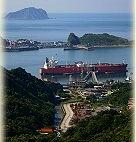
Just the Facts

Lay of the Land
Slightly Slanting Highland Row House on the Road to Dongpu
History: The Central Mountains remained an untamed frontier through the first decades of the 20th century, after which the island’s Japanese rulers made a concerted and ultimately successful effort to pacify indigenous populations and exploit the region’s resources. The Second Batongguan Trail (八通關越嶺古道), finished in 1921 with its western entrance at Dongpu (東埔), was chiseled 125km across the center of Taiwan to the East Coast. It opened the door to full scale logging, mining and - eventually - agriculture. The Alishan Forest Train that today delivers visitors from coastal plains to stations some 2,500 meters above sea level is the last operating section of an extensive narrow-gauge railway network built to remove logs. Taiwan declared its first national park at Yushan (玉山國家公園) in 1985, with conservation and restoration topping the official agenda. Today, the region’s economy relies largely on tourism and agriculture, including the cultivation of high quality wulong (Oolong) tea.


 Car or Motorcycle: The route described in this section leaves National Highway 3 (H-3) at Mingjian Exit (236km marker), follows Provincial Route (PR)-16 [台16線] for about 28km through the towns of Jiji (集集鎮) and Shuili (水里鄉), and connects with PR-21 heading south (toward Sinyi [信義]). Road signs are well marked in both Chinese and English. The route continues on PR-21 [台21線] until it “becomes” PR-18 [台18線] at the PR-21 145km marker (near the Yushan National Park Visitors’ Center at Tatajia [塔塔加]). PR-18 can then be taken all the way down the mountain to the H-3 Jhongpu Exit (297km marker). The route may be traveled in reverse as well.
Car or Motorcycle: The route described in this section leaves National Highway 3 (H-3) at Mingjian Exit (236km marker), follows Provincial Route (PR)-16 [台16線] for about 28km through the towns of Jiji (集集鎮) and Shuili (水里鄉), and connects with PR-21 heading south (toward Sinyi [信義]). Road signs are well marked in both Chinese and English. The route continues on PR-21 [台21線] until it “becomes” PR-18 [台18線] at the PR-21 145km marker (near the Yushan National Park Visitors’ Center at Tatajia [塔塔加]). PR-18 can then be taken all the way down the mountain to the H-3 Jhongpu Exit (297km marker). The route may be traveled in reverse as well.Train: Travelers focusing on the southern section of this itinerary (Yushan, Alishan and Fenqihu [奮起湖]) may consider taking the Alishan Forest Train (阿里山森林鐵路), which departs Jiayi Railway Station twice daily (once in the morning and afternoon). It is one of the world’s few high mountain railways
 still in operation and delivers (in fair weather) panoramic views largely missed from the roadway. (see this website for timetable, prices and online booking [sorry, Chinese only] or call (05) 225.1978). Travelers must reserve tickets in advance, which can booked up to 2 months ahead of time.
still in operation and delivers (in fair weather) panoramic views largely missed from the roadway. (see this website for timetable, prices and online booking [sorry, Chinese only] or call (05) 225.1978). Travelers must reserve tickets in advance, which can booked up to 2 months ahead of time.Bus: Buses, run by several different companies in different sections, make travel over this route possible, but inconvenient. Travel to Dongpu from the central West Coast is serviced by Yuanlin Motor Transport (tel: (04) 832.0101); a bus to Alishan from Jiayi City (and back) operated by Jiayi County (tel: (05) 278.8177) runs roughly every two hours until 3:10pm daily; also, Kuo-Kuang Motors (02.2311.9893) runs two round-trip buses between Taipei and Alishan every other day.
The Central Mountains offer regular reminders of nature’s ultimate dominion over us all. Snows occasionally close high passes during winter, and rockslides throughout the year mean that PR-21 is nearly always under repair. Driving across Yushan National Park after dark or during inclement weather should be avoided.

Applying for Hiking Permits: Hiking certain mountain trails requires prior registration with the local police precinct (警察局派出所). The procedure is simple and may be processed and approved immediately. Documents required include: 1) valid passport or ARC; 2) completed Application Form for Entering Restricted Mountain Areas (外國人入山申請書); and 3) processing fee (NT$10). The application form can be downloaded from here.
Accommodations: The area provides modest but comfortable accommodations in terms of both hotels and B&Bs. The following suggestions are provided for reference:
Located 1km before the town of Dongpu; Spacious surroundings; Panoramic valley views.
Located on PR-18 at the 83km marker between Tatajia and Alishan. Full view of Yushan and adjacent valley. Far from civilization, close to hiking and nature.







1 comment:
Great new addition to your Blog, along with some spectacular photos!You're exploring for us all. LM in MI
Post a Comment